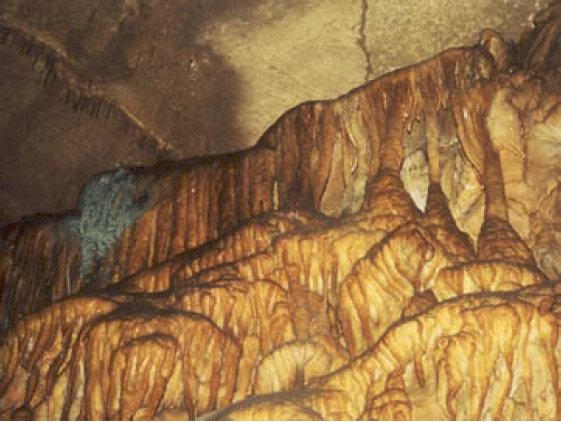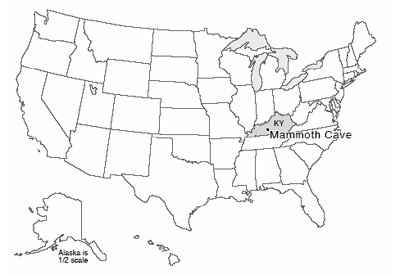
Deep beneath the rolling Kentucky hills lies Mammoth Cave. With about 390 miles (almost 630 km) of surveyed passageways, this is the longest known cave in the world, more than twice as long as second-place Jewel Cave (which is in a national monument in South Dakota, and has just under 160 miles or 260 km of surveyed passageways). The great size was achieved when a team of explorers showed that the historical part of Mammoth Cave and the even larger neighboring Flint Ridge Cave were actually connected, followed by a lot more surveying. There is every reason to expect that further connected passages remain undiscovered, and estimates extend as high as 1000 miles of total passageways.
The cave was mined for saltpeter (containing nitrates) for use in gunpowder, especially during the war of 1812. The source was bat guano (the polite name for it) deposited over the ages by great flocks of bats. Native Americans used the cave long before European settlement.
Cave Formation

The cave was dissolved in limestone. The limestone was deposited in shallow seas during the Paleozoic (a few hundred million years ago), mostly as shells of sea creatures. The limestone lies beneath sandstone from old beaches. The sandstone is a rather sturdy layer, and provides a “roof” that does not collapse easily, which is important in making Mammoth Cave so big.
As we saw in discussing rock weathering to make muds for the Badlands, rainwater and soil water are weak acids. Chemically, limestone is calcium carbonate, which is especially prone to attack by acid. The usual test for limestone is to drip a little weak hydrochloric acid on a sample; limestone fizzes vigorously as the rock decomposes, freeing carbon dioxide gas, but most other rocks react much more slowly and do not fizz. Where soil waters move through limestone, the rock dissolves and washes away rather rapidly. If the rock has lots and lots of cracks, the water may follow so many different paths and spread out the dissolution so evenly that caves are not formed. But if the limestone has just a few cracks for water to flow through, all of the dissolution will be concentrated in those few places, and cave passageways may form. Then, if the water table is lowered (say, because the nearby river has cut downward through rocks and is draining water from the rocks to its new lower elevation, as Kentucky’s Green River has done near Mammoth Cave), water will drain away and the cave will fill with air.
The beautiful stalaCtites (from the Ceiling), stalaGmites (on the Ground), and other cave formations can then develop. Because processes in soil—worms exhaling, and similar activities—typically release carbon dioxide, groundwater usually contains more carbon dioxide than does rainwater, so groundwater is more effective than rainwater at dissolving limestone. Occasionally, a cave may be so isolated from the surface that dangerous levels of carbon dioxide exist in the cave, but caves usually exchange enough air with the outside world to have near-normal levels of carbon dioxide. When groundwater drips into a cave that has a near-normal carbon-dioxide level, the water loses carbon dioxide to the air. The water then cannot hold all of the dissolved limestone, and deposits some of it to form the beautiful stone features we see.
Sometime, look at a cliff or road cut (but be careful—we don't want to lose anyone to distracted driving, or being run over along a roadside!). If you look carefully, you should see that almost all cliffs and road cuts have cracks (called joints), and that some of those joints are usually vertical; very often there are two or more sets of vertical joints, perhaps with many joints oriented north-south but many others oriented east-west. Rainwater that is not used by plants will trickle down the “pipe” where the joints intersect. If the rock around the pipe is limestone, the rock will dissolve, leaving space, although that space may fill with mud. Such a hole, whether mud-filled or air-filled, is called a sinkhole.
Sinkholes formed by downgoing waters are very common in the State College, PA area, where Dr. Alley lives. Penn State’s Geosciences Department is housed in the Deike Building, which required extra funding for special strengthening because the building has sinkholes beneath—a building can rest firmly on bedrock, but tends to fall into air-filled or mud-filled holes. Extra funds were similarly expended to strengthen the nearby Mt. Nittany Middle School, the runway extension at the airport, and other construction projects in the area. A newly constructed storm-water catch basin at the airport filled with water during the first rain, and the weight of the water blasted mud out of a buried cave passageway somewhere beneath, suddenly turning Spring Creek red with trout-choking sediment.
Where sinkholes and caves are common, streams often disappear underground into swallow holes, only to re-emerge at springs. Spring Creek is aptly named, and many other similar features occur around central Pennsylvania, around Mammoth Cave, and in other such regions. Corn cobs once were dumped in a sinkhole behind a cannery at Old Fort east of State College, and after a rain would pop out of a spring in Spring Mills, a few miles away. Regions with sinkholes, caves, springs, swallow holes, etc., are referred to as karst, after a region in Slovenia with many such features. Karst features are present across 20% of the Earth’s surface, and roughly 40% of the US population obtains drinking water from karst, according to the National Park Service.
In the past, people often threw trash into sinkholes. Big pieces would sink into the mud or fall into cave passages beneath, “disappearing.” When Dr. Alley was in high school and went to Sloan’s Valley, Kentucky to go wild caving (spelunking), one of the cave entrances was known as the Garbage Pit, which led into the Tetanus Tunnel. A commercial cave near Mammoth Cave was forced to close in the 1940s because of the stench from sewage draining in.
Slowly, we are learning just how stupid it is to dump things in sinkholes. A test run by Penn State’s hydrogeologist, the great Dick Parizek, during the building of the Nittany Mall showed that a little harmless dye dumped in a sinkhole near the mall came out in a nearby trout stream in a day or two. It should be evident that anything else dumped in a sinkhole near the Nittany Mall (or many, many other sinkholes in the region and in other karst regions) would show up very quickly in the water used by people and wildlife.
Dr. Alley lives in a house served by the Lemont Water Company, which is now well-known for fine water. But many years ago, before a reorganization of the water company, the intestinal parasite Giardia showed up in Lemont well water. Giardia causes intense and possibly dangerous gastric discomfort, and is to be avoided. Giardia usually is restricted to surface water; the spaces in most rocks are small enough to filter out the Giardia cysts before they reach a well, or the water takes so long to go from the surface to a well through the small spaces that the cysts die of old age on the way. At the long-ago community meeting to discuss the water contamination, company officials noted that they had installed well filters to remove sticks, leaves, etc., that came out of the wells with the water. In karst country, surface water can become groundwater and return to the surface in hours or days. Whole streams go down and up, and if sticks can go through, microscopic cysts can, too. Clearly, contaminants dumped somewhere today can be poisoning someone tomorrow.
In some other regions, the groundwater-contamination problems are quite different. In sandstones, for example, the water moves slowly, pore-by-pore, through the rocks. In some places, the water can be shown to have first entered the ground during the ice age, more than 20,000 years ago, or even earlier. Contaminants dumped in such rocks may not bother people for a while. But, when the contaminants do start to bother people, clean-up can be very difficult.
Try this experiment. Squirt some soap on a sponge, and squeeze the sponge a few times to distribute the soap well. The sponge is our rock, and the soap is the contaminant. Now, wet the sponge, hold it up, and squeeze it. Foamy, soapy water will come out. Wet the sponge again, squeeze it again, and more soap comes out. Repeat, and repeat, and repeat. You may need ten or more times to remove enough soap that you no longer see it, and sensitive instruments would detect the soap through dozens or even hundreds of additional washings. Now, suppose that we had not soap, but a chemical that causes cancer in humans. If the water in the rocks naturally is hundreds or thousands or more years old, then nature takes a long time to wash out the rocks once, and washing them out ten or one hundred times will take much longer than all of human history.
There are things that can be done about groundwater pollution. You can pump clean water in and dirty water out, or pump steam or hot water in and out (and then try to figure out how to clean the dirty water or steam once you have them on the surface). People are experimenting with installing filters so that polluted water will flow through them, sometimes using large masses of iron filings to react with and break down some organic chemicals in groundwater. Geomicrobiologists are prospecting really dirty sites for “bugs” that “like” to eat pollutants, and then trying to introduce those microorganisms into other polluted sites; other biologists are looking into ways to design pollutant-eating microbes. But, such techniques usually are very expensive and not very effective. Most people who have thought about it agree very strongly that the best way to handle groundwater pollution is to keep the chemicals out of the ground in the first place. A whole lot of money has been spent on clean-up because we did not learn that lesson soon enough—and there are days when it appears that we have not yet learned that lesson.